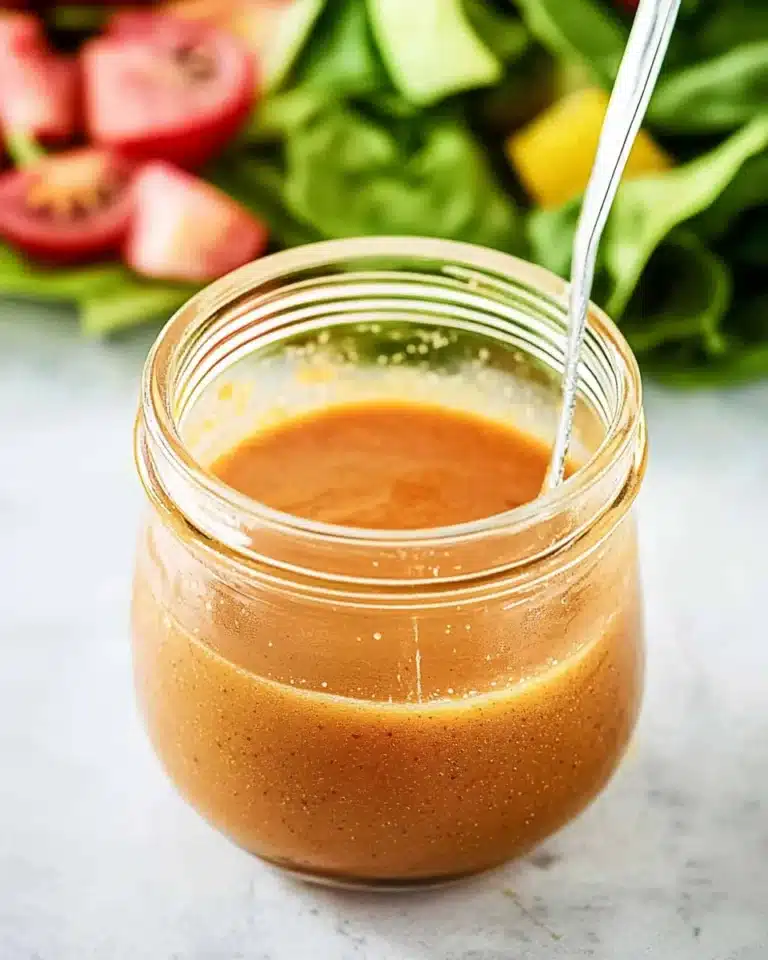5 Easy Ways to Make Creamy Greek Salad Dressing

If you’ve ever craved that rich, tangy, and irresistibly smooth touch that elevates a simple salad, then you’re in for a treat! This post shares 5 easy ways to make creamy Greek salad dressing that brings bold Mediterranean flavors right to your kitchen. Whether you’re tossing fresh cucumbers, ripe tomatoes, or crisp romaine, this creamy dressing adds a luscious layer of flavor and texture that makes every bite unforgettable. From classic yogurt bases to inventive twists, you’ll discover how simple ingredients combine to create that perfect creamy Greek salad dressing you’ll want to drizzle on everything.
Why You’ll Love This Recipe
- Effortless flavor boost: These creamy Greek salad dressing recipes turn ordinary salads into extraordinary meals with minimal effort.
- Versatility at its best: Perfect for salads, dips, marinades, or even sandwiches, making it a kitchen staple.
- Health-friendly options: Many variations include wholesome ingredients like Greek yogurt and olive oil, keeping it light yet satisfying.
- Quick to whip up: Each method takes just minutes, so you’re ready to enjoy fresh dressing anytime craving strikes.
- Customizable to taste: Easily adjust herbs, acidity, or creaminess to suit your personal preference or dietary needs.
Ingredients You’ll Need
Creating creamy Greek salad dressing is all about combining simple, fresh ingredients that each play an essential role—whether it’s tang, creaminess, or herbaceous flavor. Here’s what you’ll want to gather before getting started.
- Greek yogurt: The creamy base that provides protein and a luscious texture without overpowering the herbs.
- Extra virgin olive oil: Adds richness and smooth mouthfeel, plus those wonderful fruity Mediterranean notes.
- Lemon juice: Brings bright, zesty acidity that balances the creaminess perfectly.
- Garlic: A punch of savory depth that’s classic in Greek flavors and brightens the overall profile.
- Dried oregano: The quintessential herb that gives Greek dressing its signature aroma and flavor.
- Red wine vinegar: Adds subtle tang and a hint of sharpness to enhance brightness.
- Salt and pepper: Simple seasonings that elevate every ingredient and tie the flavors together.
- Feta cheese (optional): Crumbled into the dressing or on top, for that iconic salty creaminess.
Variations for Creamy Greek Salad Dressing
One of the joys of creamy Greek salad dressing is how easy it is to tweak for different tastes, dietary preferences, or ingredient availability. Here are some popular and delicious ways to customize your dressing:
- Vegan option: Substitute Greek yogurt with a plant-based alternative like cashew cream to keep it creamy and dairy-free.
- Feta-infused: Blend crumbled feta directly into the dressing for an extra layer of richness and saltiness.
- Herbal twist: Add fresh dill or mint alongside oregano for a more aromatic and fresh variation.
- Spicy kick: Sprinkle in red pepper flakes or a bit of cayenne to awaken the dressing with gentle heat.
- Avocado creaminess: Puree half an avocado into the base for a buttery texture and added nutrients.

How to Make Creamy Greek Salad Dressing
Step 1: Gather fresh ingredients
Start by measuring out all your components—Greek yogurt, olive oil, lemon juice, garlic, oregano, vinegar, and seasonings—to ensure a smooth and efficient mixing process.
Step 2: Combine yogurt and olive oil
In a mixing bowl, stir the Greek yogurt and extra virgin olive oil together until smooth; this creates the luscious creamy foundation for the dressing.
Step 3: Add the acidic elements
Whisk in freshly squeezed lemon juice and red wine vinegar carefully to balance tanginess with creaminess, brightening the overall flavor.
Step 4: Season with garlic, oregano, salt, and pepper
Mix in finely minced or pressed garlic and dried oregano, then add salt and pepper to taste — this blends the classic Greek flavor profile with savory depth.
Step 5: Optional add-ins and blending
If you’re adding feta cheese, avocado, or herbs like dill or mint, fold them in now or blend slightly for a smooth, rich texture that’s uniquely yours.
Step 6: Chill and serve
Let your creamy Greek salad dressing chill in the fridge for at least 30 minutes to allow the flavors to meld beautifully before drizzling over your salad.
Pro Tips for Making Creamy Greek Salad Dressing
- Use full-fat Greek yogurt: It delivers the best creaminess and authentic taste, though low-fat can work in a pinch.
- Fresh lemon juice matters: Always squeeze fresh lemon for that bright, vibrant acidity rather than using bottled juice.
- Slowly add olive oil: Drizzle olive oil gradually while whisking to create a perfectly emulsified texture.
- Chill before serving: The resting time intensifies the flavors and helps the dressing thicken slightly.
- Taste as you go: Adjust seasoning at the end, you might want a bit more salt, lemon, or herbs depending on your preference.
How to Serve Creamy Greek Salad Dressing
Garnishes
Top your salad with fresh herbs like oregano or parsley, sprinkle crumbled feta, or add sliced Kalamata olives to complement the creamy dressing and make every bite flavorful and colorful.
Side Dishes
This creamy Greek salad dressing pairs beautifully with grilled chicken, pita bread, roasted vegetables, or as a dip for crunchy crudités, making your meal complete and satisfying.
Creative Ways to Present
Serve the dressing in rustic small bowls alongside build-your-own salad bars, drizzle artistically over a composed Greek salad platter, or even use it as a dollop on Mediterranean bowls with quinoa and roasted chickpeas.
Make Ahead and Storage
Storing Leftovers
Keep any leftover creamy Greek salad dressing in an airtight container in the refrigerator for up to one week to maintain freshness and flavor.
Freezing
While freezing is not generally recommended for creamy dressings because of texture changes upon thawing, you can freeze the base ingredients like yogurt and olive oil separately to mix fresh later.
Reheating
Reheat creamy Greek salad dressing gently at room temperature if needed, but avoid microwaving as it can break the emulsion and affect texture.
FAQs
Can I make creamy Greek salad dressing without Greek yogurt?
Yes! You can substitute Greek yogurt with sour cream, mayonnaise, or plant-based alternatives like cashew cream for different textures and dietary needs.
How long does homemade creamy Greek salad dressing last?
Stored properly in the fridge, it typically stays fresh for about 5 to 7 days, but always check for changes in smell or texture before using.
Is this dressing suitable for a ketogenic diet?
Absolutely! Using full-fat Greek yogurt and olive oil keeps it low-carb and keto-friendly, but avoid adding sweeteners or high-carb ingredients.
Can I adjust the creaminess of the dressing?
Yes, adjust creaminess by adding more Greek yogurt to thicken or a splash of water or lemon juice to thin the dressing to your preferred consistency.
What salads go best with creamy Greek salad dressing?
This dressing complements classic Greek salad ingredients like cucumbers, tomatoes, onions, and olives, and works wonderfully with grain bowls and grilled vegetable salads too.
Final Thoughts
There’s nothing quite like the vibrant taste and indulgent texture that homemade creamy Greek salad dressing brings to the table. With these 5 easy methods, you’ll find yourself reaching for it again and again to brighten meals, impress guests, or just elevate everyday salads into something truly special. Give it a try, customize it to your heart’s desire, and watch how this simple dressing becomes your new kitchen favorite.
Related Posts
- Best Chicken Marinades to Boost Flavor Fast
- Why Alabama White BBQ Sauce Is a Game Changer
- Lemon Vinaigrette Salad Dressing: Fresh and Easy Recipe

Creamy Greek Salad Dressing
A rich, tangy, and creamy Greek salad dressing that brings bold Mediterranean flavors to your kitchen. Perfectly balanced with Greek yogurt, olive oil, lemon juice, and traditional herbs, this versatile dressing elevates salads, dips, and more with minimal effort and wholesome ingredients.
- Total Time: 40 minutes (including chilling time)
- Yield: About 1 cup (serves 6-8) 1x
Ingredients
Base Ingredients
- 1 cup Greek yogurt (full-fat recommended)
- 1/4 cup extra virgin olive oil
- 2 tablespoons freshly squeezed lemon juice
- 1 tablespoon red wine vinegar
Seasonings & Herbs
- 1–2 cloves garlic, finely minced or pressed
- 1 teaspoon dried oregano
- Salt and freshly ground black pepper, to taste
Optional Add-ins
- 1/4 cup crumbled feta cheese
- Fresh dill or mint leaves, chopped (about 1 tablespoon)
- Red pepper flakes or cayenne, a pinch
- 1/2 ripe avocado, pureed
Instructions
- Gather fresh ingredients: Measure out Greek yogurt, olive oil, lemon juice, garlic, oregano, red wine vinegar, salt, and pepper to prepare for mixing efficiently.
- Combine yogurt and olive oil: In a mixing bowl, stir the Greek yogurt and extra virgin olive oil together until smooth, creating the creamy base.
- Add the acidic elements: Whisk in freshly squeezed lemon juice and red wine vinegar carefully to balance the tanginess and brighten flavor.
- Season with garlic, oregano, salt, and pepper: Mix in finely minced garlic and dried oregano, then add salt and black pepper to taste, blending classic Greek flavors.
- Optional add-ins and blending: Fold in crumbled feta cheese, fresh herbs like dill or mint, red pepper flakes, or avocado puree as desired for extra richness, spice, or creaminess. Blend slightly if needed for uniform texture.
- Chill and serve: Refrigerate the dressing for at least 30 minutes to allow flavors to meld and the texture to thicken slightly before serving over salads or as a dip.
Notes
- Use full-fat Greek yogurt for best creaminess and authentic taste; low-fat versions can be used in a pinch.
- Always use fresh lemon juice rather than bottled for vibrant acidity.
- Drizzle olive oil slowly while whisking to emulsify the dressing properly.
- Adjust seasoning after chilling since flavors intensify during resting.
- Store leftover dressing in an airtight container in the fridge for up to 7 days.
- Freezing the dressing is not recommended due to texture changes upon thawing; freeze base ingredients separately if needed.
- Reheat gently at room temperature if necessary; avoid microwaving to preserve emulsion.
- Prep Time: 10 minutes
- Cook Time: 0 minutes
- Category: Appetizers
- Method: No-cook
- Cuisine: Mediterranean
- Diet: Gluten Free, Keto Friendly, Vegetarian
Nutrition
- Serving Size: 2 tablespoons
- Calories: 80
- Sugar: 1 g
- Sodium: 120 mg
- Fat: 7 g
- Saturated Fat: 1.5 g
- Unsaturated Fat: 5 g
- Trans Fat: 0 g
- Carbohydrates: 2 g
- Fiber: 0.3 g
- Protein: 2 g
- Cholesterol: 5 mg
Keywords: Greek salad dressing, creamy dressing, Mediterranean dressing, healthy salad dressing, yogurt dressing, easy Greek dressing






